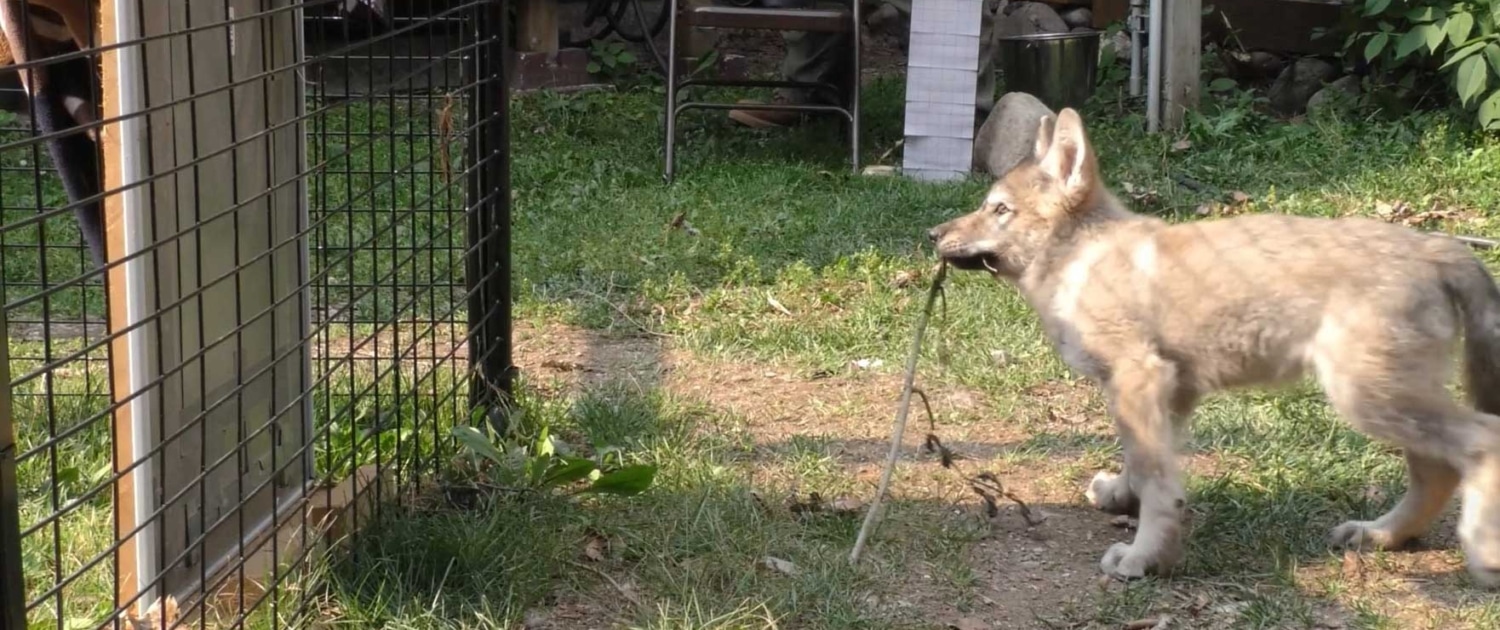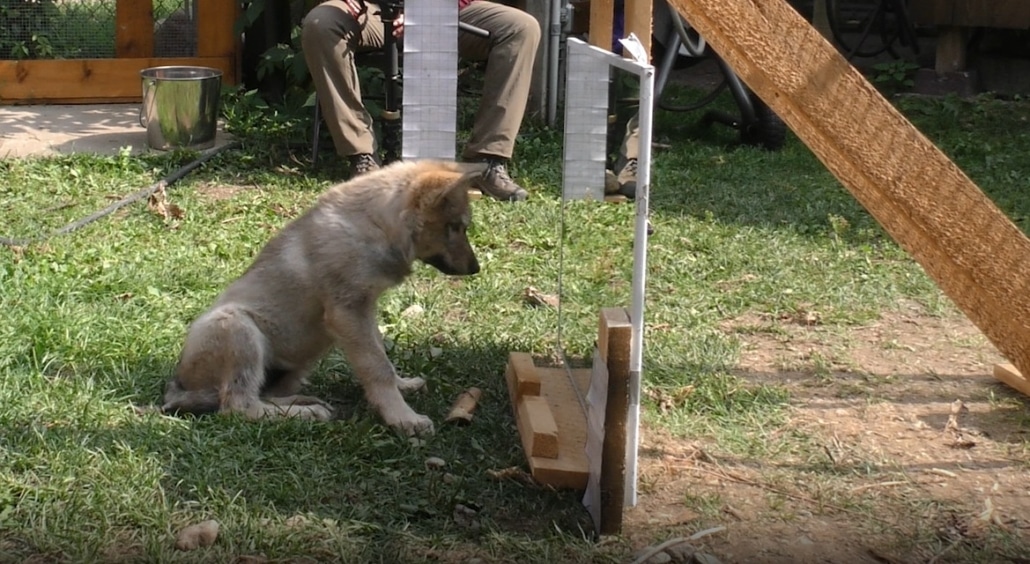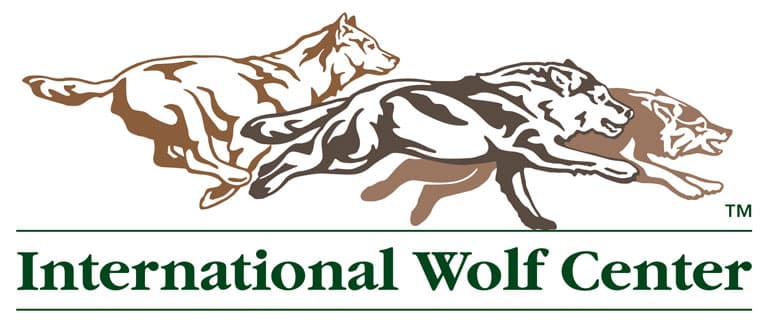Countless times a day, we humans walk by reflective surfaces. No longer are we surprised to see ourselves staring right back.
But in that same kind of scenario, what would a captive wolf pup do? That was the question behind a research project recently completed at the International Wolf Center by Matheus de Mesquita Silveira, Lori Schmidt, Heloísa Allgayer and Shannon Barber-Meyer.
In the summer of 2021, the researchers studied a pup at the Center named Rieka. At 72 days old, Rieka was first exposed to a covered mirror. The mirror was placed in a grassy area she was familiar with and over four 10-minute sessions around the covered mirror, Rieka’s behavior was closely watched. Then, five similar sessions were observed with the mirror uncovered.
Rieka’s reactions to the mirror were recorded using two video cameras and two cell phones positioned to capture behaviors from multiple angles.
The analysis focused on six wolf behaviors grouped into three categories: negative (anxiety, fear, submission), positive (playfulness, interest, relaxation) and neutral (disinterest).
Behaviors were classified based on bodily signals like ear and tail positions, hackle intensity, walking stance, and resting posture, interpreted alongside environmental context.
The findings were reported in this paper.

What researchers observed
“For the first four sessions when the mirror was covered, Rieka briefly gazed at the back of the mirror, which displayed a glass surface similar to a window,” researchers wrote. “Depending on the angle of light incidence, a small percentage of light could be reflected back. During this period, she presented no interest in the mirror’s structure or investigated its surrounding area. The observations showed that her focus was on other stimuli (namely, personnel, branches, turkey feathers, bones, and grids) rather than the mirror’s surface, structure, or the fence in front of it.”
When the mirror was uncovered, researchers recorded much different behavior.
“Rieka’s behavioral reactions to the mirror transitioned from anxiety and fear avoidance to interest and relaxation, with no signs of either submission or playfulness,” researchers wrote. “Notably, her reactiveness ranged from hesitation to engaging with strong anxiety to increasing confidence with focused interest.
Initial reaction
 In her first session after the mirror was uncovered, Rieka’s first mirror reactions indicated a fear response, followed by increasing anxiety with interest in the mirror.
In her first session after the mirror was uncovered, Rieka’s first mirror reactions indicated a fear response, followed by increasing anxiety with interest in the mirror.
Her tail was tucked, researchers wrote, and her ear posture indicated an interest with hesitation to engage in interactions. But by the end of that first session with the uncovered mirror, she had a “significantly more relaxed body posture” than in her previous interactions with the mirror.
“By the end of the last session with the uncovered mirror, Rieka shifted from curiosity with low levels of anxiety in her mirrored reflection to a relaxed posture without any interest in the reflective surface,” researchers wrote. “Rieka stayed laid down and did not exhibit any other mirror-related reactiveness for the remainder of the last session.”

So what did researchers learn?
“The observation of Rieka’s reactions to the mirror unveils insights into her behavior dynamics and contributes to the understanding of mirrored visual stimuli in non-domesticated canids,” wrote researchers.
There were three hypotheses put forward to account for her behavioral change:
1) habituation to the mirror;
2) recognition that the mirrored image does not represent a real wolf; and
3) development of self-confidence towards the unfamiliar canid reflection.”
Researchers wrote:
“The absence of playful and submissive responses undermines the third hypothesis. However, the exact perceptions and triggers for Rieka’s behavioral shifts in relation to hypotheses 1 and 2 remain undetermined. Her engagement with the reflection could stem from wolves’ tendency to respond to visual cues and their significant reactivity towards novel stimuli. Her initial negative response might be attributed to the neophobic nature of wolves, which would explain her anxious and fear-avoidance behaviors. Throughout the sessions, she repeatedly focused on the mirror, transitioning from negative reactions to observing the reflective surface with interest and, eventually, without evident fear.”
In conclusion, researchers wrote that Rieka’s initial reactions were marked by fear-avoidance, in contrast to playful behavior exhibited by dog pups in similar research settings and the investigative reactions observed in adult wolves.
Over time, Rieka’s reactions changed from fear-avoidance and anxiety to interest and relaxation, while adult wolves tested by Barber-Meyer and Schmidt did not exhibit negative reactions and quickly transitioned from investigative behavior to disinterest. Similarly, dog pups tested previously demonstrated more reactivity to their mirrored reflections compared to adult dogs, paralleling the difference in behavioral responses reported for Rieka and adult wolves.
“It is plausible that Rieka’s initial fear-avoidance and anxiety behavior resulted from not being acclimated to the mirror, in contrast to adult wolves that might have habituated to reflections seen in water or glass windows. While further research is necessary to confirm these conjectures, the observations seemed to go against the hypothesis that prolonged exposure to reflective surfaces could increase canids’ reactivity to mirrors, with age and repeated exposure potentially influencing their responses.”

The International Wolf Center uses science-based education to teach and inspire the world about wolves, their ecology, and the wolf-human relationship.
